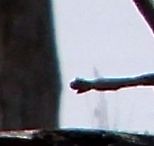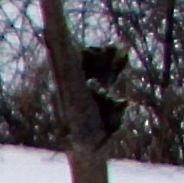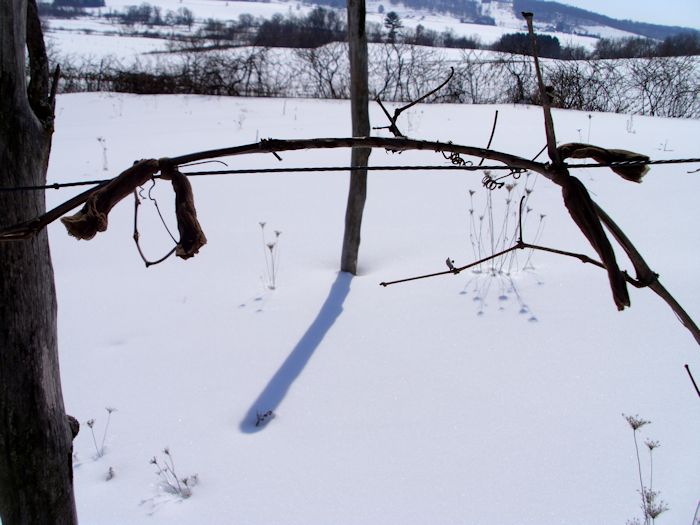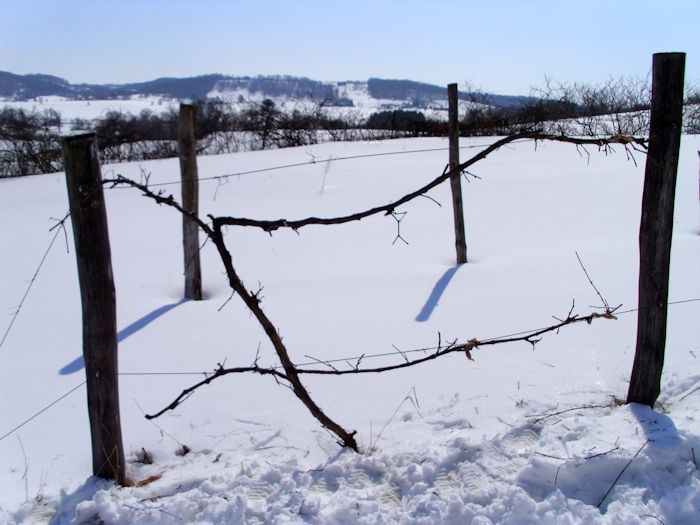It has been a while since I wrote Pruning the Grapes (Part 1). Of course, the grapes were actually pruned long ago. In fact, the biggest impediment to my pruning the grapes was the knee deep snow in many areas of the orchard. We still have some snow, but it has greatly diminished since then. In that first post I described some of the conclusions I had reached from pruning our own grapes and watching others work with their canes. I also mentioned that we use a four-cane Kniffin system for pruning purposes. I decided to grab a few pictures of the pruning process, in part, because the pictures in books sometimes make it hard to see precisely what you should do. This is just one method of how to prune grapes, but there are several other ways of doing so. If you’re wanting to learn to prune grapes, then carry on reading for my version –
There are actually two kinds of buds on a grape cane. The first is sharp and pointy like the one shown here.
This bud type produces the leaves later in the season. The second is rounder, almost globular like the one shown here.
This bud type produces the flowers that will eventually produce the grapes. The concept that completely eluded me at the outset was that a grape won’t produce any more buds for the current year after the previous year’s growing season. In other words, the buds you grow this summer are for next year’s fruit. When you prune, you must prune with the idea that the buds you have now are the only buds you’re going to get, so you need to prune carefully. A lot of the books also fail to point out that you want to keep the buds nearest the main branch so that the grapes receive sufficient water and nutrients. Finally, each spur should have only two or three fruiting buds-the globular ones. The spur can have any number of leaf buds-more is better in this case.
Some of these pictures are a bit hard to see because the light was intolerably harsh on the day I worked on the vines. However, there are a few things you should notice in this picture:
Notice that the spurs coming off the main cane don’t necessarily point down as it always seems to show in the pictures in books. The spurs will eventually point in the right direction because the grapes will pull them down. Don’t worry about spur direction-look instead for the spurs that have the nicest fruiting buds.
Also notice that the canes are tied to the steel cable. You need to put the canes in contact with the cable to promote attachment to it. Those curlicues coming from the cane are actually quite strong and will hold it in place, but only if they actually curl around the steel cable. You can’t use anything harsh to tie the canes in place. We actually use old pairs of pantyhose that have been cut up into usable pieces. The pantyhose are quite inexpensive and last several years (as many as five) before they start to disintegrate too badly. The most important part though is that they hold well without causing damage to the cane. Using a steel cable manufacturer you can trust is important to make sure your machinery is working properly and efficiently for you.
When you get done, your cane won’t look quite as pretty as the ones in the book. In fact, grape vines tend to look a bit gnarled. Here is how the pruned vine looked this year when I got done with it.
You can see the trunk, the four fruiting canes, and the spurs coming from the canes. The canes are looped or tied to the steel wire as needed. I’ll actually retie the lower left cane when the season progresses. At the time I pruned the cane, I was a bit worried about breaking it, so I left it as is. The upper right cane will also require a bit more support. Again, I chose to wait until it warms up a bit and the cane is more flexible. This grape vine will likely produce sixteen nice sized clusters of medium-sized grapes that I’ll eventually use to make wine or Rebecca will use for jelly or juice.
This is my approach to pruning grapes. Of course, there are many schools of thought on the issue. However, what I do hope is that the combination of pictures and some insights will help you get better grapes out of your vines. Let me know your thoughts on grape pruning at [email protected].




